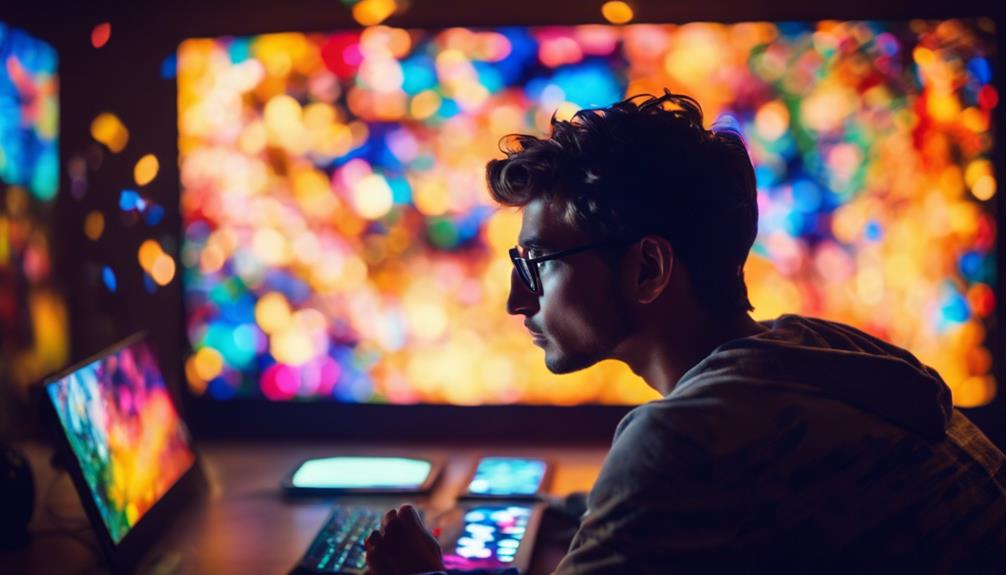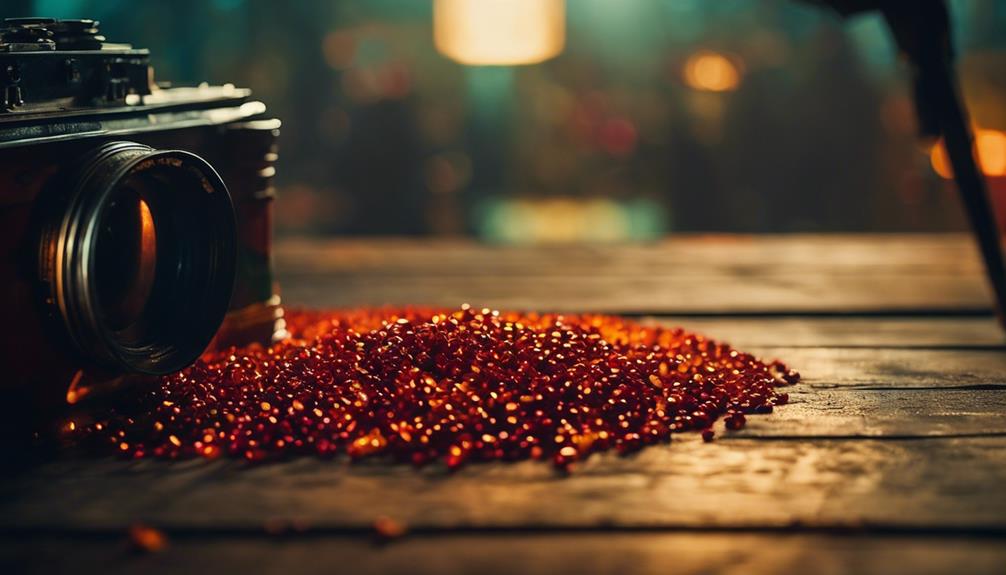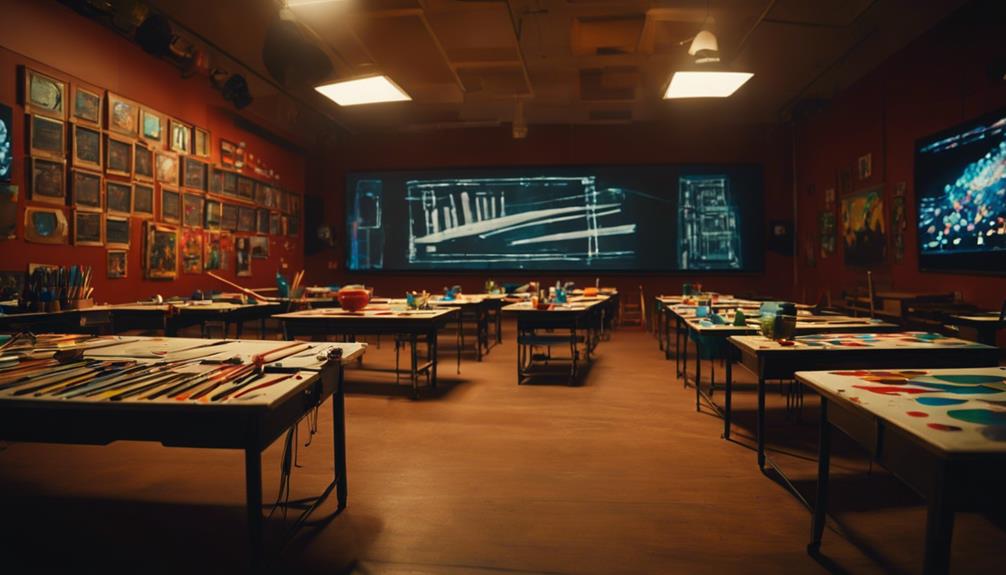Free Art Generators Impact Artistic Integrity
The rise of free art generators has kicked off a heated discussion about their effect on the core values of artistry. Supporters see it as a way to make art more accessible to everyone, but there’s a strong argument against it, highlighting the loss of personal touch and the depth of emotion that comes with traditional art. This clash between new technology and established methods brings up crucial questions. Is it possible for a machine to mimic the depth of human creativity? What does this change mean for the future of art and those who create it? These issues prompt us to think more about how art is changing in today’s world.
Art needs to evolve, but it’s vital to remember why it’s unique. Artistic integrity matters because it connects us on a human level. As we move forward, we must keep asking ourselves how to incorporate new tools without losing the essence of what makes art meaningful.
Key Takeaways
The emergence of free art generators sparks a debate on art’s essence. Advocates argue these tools democratize creativity, yet critics fear they undermine human-made art’s unique, emotional connection. This tension underscores important questions about creativity’s future and its authentic expression.
- Accessibility versus authenticity in art is a hot topic.
- Can machines replicate human creativity? Doubt remains.
- It’s crucial to balance innovation with preserving art’s soul.
Art continues to evolve, but its unique nature, rooted in human emotion and connection, must not be overlooked. As we adapt to new creative tools, maintaining the integrity of art is essential for its continued relevance and impact.
The Rise of Automated Art
The emergence of AI tools for creating art is changing how we see and make art. These advanced programs can quickly create a wide range of images, which shakes up the traditional way of making art. Now, we must think hard about what creativity means when machines can earn art, too. This new type of art can fill up the market with images that might look good but could be missing the special something that human artists bring. This could make people question how unique and authentic art is now.
Moreover, easy access to these art-making tools could undercut the value of professional artists’ work. With these programs becoming more popular, there’s worry about whether old-school art can keep up with such fast technology.
In short, AI in art is a significant change that makes us rethink what art is and how we value it. It’s a reminder that creativity and art will always be essential discussions as technology grows.
Defining Artistic Integrity

Artistic integrity is crucial for maintaining authenticity, originality, and a unique personal voice in art. This concept becomes even more relevant with the rise of art generators, sparking debates on balancing creativity with technology and keeping art original during the creative process. Examining how new technologies might challenge or support true artistic expression is essential.
Artistic integrity ensures artists stay true to their vision, even in a world filled with technological shortcuts. Artists who use tools like art generators face the challenge of blending their creativity with automation without losing their unique voice. This balance is critical to preserving the integrity and originality of their work. It’s about using technology as a tool, not letting it take over the creative process.
Essence of Authentic Art
Understanding the true nature of authentic art means recognizing the artist’s strong focus on originality and personal expression. This dedication to creating something unique is not just about the art piece itself but is rooted in the entire creative journey. It shows how deeply an artist sticks to their principles and values.
Authentic art stands out because it clearly connects the creator and their work. This connection is built on honesty, sincerity, and a natural emotional bond. The real value of such art comes from the purity and truthfulness of its creation.
Here, the artist’s commitment to their craft and vision stays true, unaffected by outside pressures, which keeps the integrity and genuineness of their work intact.
Creativity Vs. Automation
Investigating the balance between human creativity and the advancement of automation brings to light significant challenges in preserving the essence of art in today’s world. The core of artistic integrity is deeply connected with the artist’s involvement, emotional input, and distinctive creative flair. However, these vital elements are at risk of being eclipsed by the ease provided by AI art tools. While these tools represent progress, they raise questions about the genuineness and innovation of artistic works.
- A personal touch against the outcomes of algorithms
- Emotional depth against predetermined reactions
- Original creativity against duplicated designs
- The vision of an artist against the operation of a machine
- Distinctiveness against conformity
The conversation around creativity versus automation underlines the importance of finding a middle ground that respects the artist’s vision and talents. These are qualities that might diminish with too much dependence on automated solutions.
Maintaining this balance is crucial for ensuring that art remains a true reflection of human emotion and thought rather than a product of technological convenience. By valuing the irreplaceable aspects of human creativity, we can continue to cherish art that resonates personally and stands out for its authenticity.
Originality in Art Creation
Exploring the idea of originality in art creation highlights how critical it is for artists to maintain their personal touch. This means staying true to their unique vision, style, and expression. Artists should avoid copying others, using someone else’s ideas without permission, or depending too much on tools, including those that create images with AI. Such tools, while innovative, might lead to a flood of content that looks good but misses the depth that only a human artist can bring. Artistic integrity demands that artists commit to their viewpoint, ensuring their work reflects human creativity and thought.
Keeping this integrity involves a dedication to one’s voice and perspective, ensuring that the art stands as a valid symbol of human expression and innovation.
The Human Touch in Art

The uniqueness of human creativity in art cannot be sidelined. It brings together feelings, lived experiences, and the artist’s singular outlook, aspects that machines find hard to replicate with authenticity. The imperfections seen in art, often seen as a mark of personality and truth, highlight the unmatched human touch. This fosters a stronger connection between the maker and the viewer.
Moreover, the emotional impact of art crafted by humans is at risk of fading if the process lacks human involvement and insight. Art is not just about the final piece but also about the story and emotions behind it, which are deeply human elements.
Essence of Human Creativity
Though artificial intelligence has advanced in recreating human-like art, it can’t match the emotional depth and personal stories at the heart of human creativity. Intellectual property rights highlight the unique and non-replicable nature of art people create. This difference matters because it includes the following:
- The authenticity that echoes our own life experiences.
- The originality that comes from someone’s unique view of the world.
- The emotional connection that feels deeply personal.
- The complicated choices artists make.
- The spontaneous ideas that spark new creations.
These aspects show why human creativity in art is so valuable and something artificial intelligence can’t replicate, especially when connecting emotionally and intellectually.
Imperfections Define Personality
When looking at handcrafted art, it’s clear that what some might call imperfections make the artwork unique. These minor quirks, from how a brush moves across the canvas to the uniqueness of each line, bring out the artist’s personality. They’re not mistakes; they’re what makes an artwork genuine and full of life.
These so-called flaws do more than add character. They create a strong connection between the artwork and the person looking at it. Each brushstroke or irregular line tells a story, sharing the artist’s vision and emotions with the viewer. This connection is vital. It’s what makes art feel real and alive, touching people personally.
| Aspect of Art | Impact of Imperfections |
|---|---|
| Emotional Connection | It makes art more relatable |
| Realness | It brings a sense of the past |
| Distinction | Sets it apart from computer-made art |
| Personality | Highlights the artist’s unique approach |
| Recognition | Forms a memorable identity |
Art isn’t about being perfect. Celebrating these unique traits ensures that every piece of art shares a different story that can deeply move people. It’s a reminder of the value of the human touch in art. This touch brings authenticity and genuine emotion, something that’s increasingly important in today’s world.
Emotional Resonance Lost
The charm found in handcrafted art is unmatched because it carries the artist’s personal touch, something AI-generated art struggles to replicate. When art is made by hand, it reflects human emotions and personal stories that are deeply intertwined with the creator’s experiences. These elements bring a unique depth and authenticity to the artwork, making it resonate emotionally with the audience. In contrast, despite its advances, AI often misses out on capturing this essence.
Art created by humans has subtle details and a soulfulness that evoke strong feelings in those who view it. There’s an authentic connection between the artist and their work, crucial for making the art feel alive and full of emotion. However, AI-generated pieces tend to lack this connection and the depth that comes from personal experience. This creates a gap in emotional resonance with the audience, highlighting a fundamental limitation of AI in art.
The Impact on Emerging Artists

The rise of AI art generators is shaking up the scene for new artists, making it more challenging to find those previously available gigs. These generators can churn out everything from fan art to logos and even illustrations for indie authors. They’re not just about creating images; they’re changing how visual content is sourced. Clients who choose AI over humans to cut costs make it harder for up-and-coming artists and designers to get noticed and land jobs.
While the art world feels pressure from AI, not every area is hit equally hard. Take children’s book illustration, for example. This area still values artists’ unique human touch, offering some resistance to the digital wave. But that’s a small comfort in the face of a growing trend, making it more challenging for new artists. They’re finding it increasingly difficult to make a name for themselves and succeed in an industry that favors the affordability and speed of AI for creative tasks.
Quality Versus Quantity

The balance between quality and quantity is tipping in today’s art world. With tools like Stable Diffusion and Deep Dream Generator, creating art has never been faster. But this speed comes at a cost. The market is now flooded with pieces that might catch your eye but don’t necessarily touch your heart.
Why does this matter? When there’s so much art out there, it’s tough for any artist to stand out. People are overwhelmed by choices, making it hard to spot the truly remarkable works. Art’s value is getting tricky to gauge as the line between factory output and handcrafted masterpieces gets fuzzy. Artists who’ve spent years honing their craft are losing out to a wave of quick and easy visuals. Plus, when art becomes something you can mass-produce, it loses a bit of its soul. This isn’t just about artists making a living; it’s about preserving art’s role in society.
The Loss of Creative Process

Using free art generators seems like an easy fix for creating art, but it takes away from the artist’s creative journey. These tools can quickly produce authentic images, but they skip over the essential steps of learning and growing through practice. This means artists miss the chance to make mistakes, learn from them, and develop a unique style. This stunts individual artists’ growth and makes the art world less diverse and exciting.
When artists rely too much on these generators, we see many of the same kinds of images, especially on social media. This makes it hard for unique and personal artwork to stand out. Skills that have been the foundation of art for centuries are becoming less valued, and the joy of creating something from start to finish is getting lost. This shift is not just a problem for artists but for anyone who appreciates the value of original and heartfelt artwork.
In a nutshell, while technology offers new tools for creation, we mustn’t forget the value of the human touch in art. The process of creating, from having an initial idea to bringing it to life, is irreplaceable and truly makes art unique.
Artistic Expression and Authenticity

Authentic artistic expression stands as a pillar of true creativity, setting apart art created by humans with its rich emotional depth and personal flair. This contrasts with algorithm-generated art, where the human touch is noticeably absent. The ongoing debate about the capability of art generators to capture the full spectrum of human emotions and experiences highlights a significant gap. AI, using algorithms and text prompts, might churn out visually attractive pieces, but these creations miss the mark on authenticity that only comes from the human soul.
- AI art often overlooks the nuances of human feelings and life stories.
- Text prompts fall short of capturing the breadth of human creativity and interpretation.
- The lack of a personal journey in creating AI art results in an authenticity gap.
- Human artists bring unique insights to their work that AI cannot mirror.
- The emotional impact of art stems from the artist’s input, which is missing in AI-generated pieces.
This analysis points to an underlying fact: while technology can imitate the look of artistic creations, it cannot duplicate the essence of creative expression and authenticity. The human element is crucial, driven by personal experiences, emotions, and viewpoints. It underscores the irreplaceable nature of genuine artistic integrity.
The Future of Art Education

As the art world changes, schools are quickly bringing in digital tools and AI to help students master the new skills they need for today’s art scene. This significant change in art education means finding the right mix of old art values and new tech methods. Teaching students about AI in art goes beyond showing them how to use new gadgets. It’s also about guiding them to make art thoughtfully and ethically with these tools.
Teachers are now focusing on the need to think about the ethical side of using AI in art. This means having students think deeply about how these technologies affect their creativity and the honesty of their work. Art education now aims to give students a strong foundation in traditional art and tech, helping them find their unique style and handle the new challenges AI brings to the art world.
Public Perception of Art Value

The introduction of AI into the art scene has stirred quite a conversation. Yet, the value people place on art still leans heavily towards the genuine and emotionally stirring qualities found in art made by humans. Art’s worth lies in its ability to express complex feelings, narrate stories, and form a personal connection with its audience. This value appears to be lessened when the art is made by algorithms, which lack personal experiences or emotional contributions.
Highlighting differences between traditional and AI-created art illustrates a few points:
- Traditional art is prized for its uniqueness and the artists’ personal narratives.
- Art lovers often seek a meaningful emotional bond with the artwork, cherishing the human effort involved.
- AI-created art, despite being groundbreaking, is often seen as missing emotional richness and genuine authenticity.
- The creative journey in making traditional art is a big part of what makes it valuable, a journey missing from AI-created art.
- In the end, art’s value in the eyes of the public is tightly linked to the human story and interpretation, something AI-created art finds hard to mimic.
Frequently Asked Questions
Why Are Artists Against Ai-Generated Art?
- Artists worry about losing their jobs and unique expression.
- Machine-made art misses the human touch and emotion.
- Legal concerns over copyright and originality loom large.
What Is the Controversy With AI Art Generators?
- Ethical issues arise as AI questions human creativity’s value.
- Concerns about originality as AI could diminish artists’ roles.
- AI art generators spark debates on cultural impact.
Is It Bad to Use Ai-Generated Art?
- AI art challenges human creativity and value.
- It spurs debate on ethical use in art.
- It calls for a balance between technology and originality.
Are There Any Truly Free AI Art Generators?
- Free AI art tools may offer limited features.
- Lower quality outputs can affect satisfaction.
- Creative options might be restricted.
